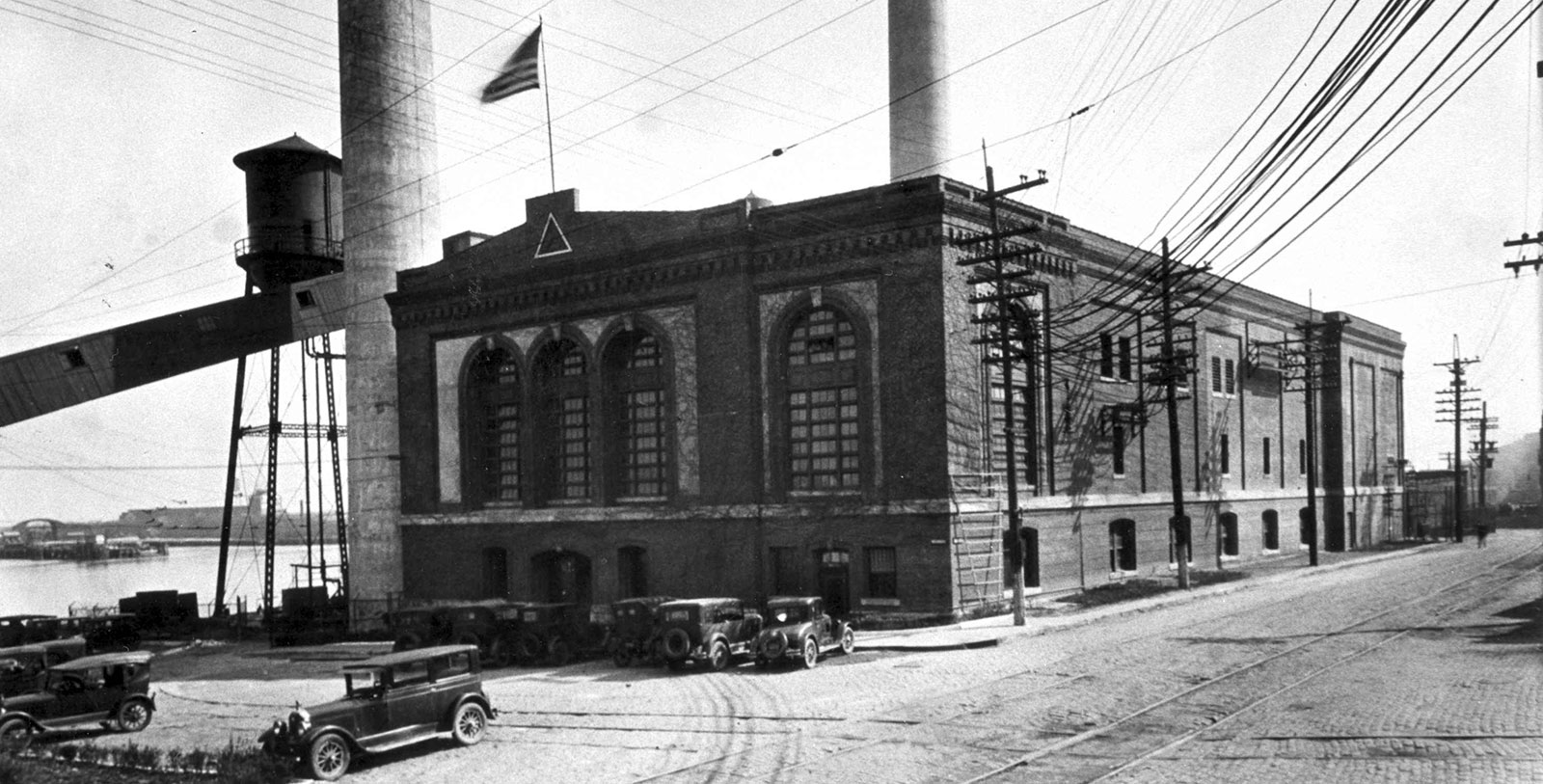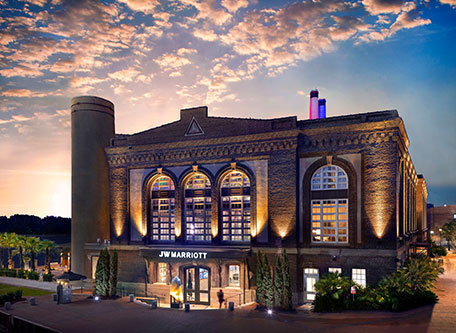Receive for Free - Discover & Explore eNewsletter monthly with advance notice of special offers, packages, and insider savings from 10% - 30% off Best Available Rates at selected hotels.
history
Discover JW Marriott Savannah Plant Riverside District, which was once the bustling power plant for the city of Savannah throughout much of the 20th century.
JW Marriott Savannah Plant Riverside District, a member of Historic Hotels of America since 2022, dates back to 1912.
VIEW TIMELINE
Discover the history behind JW Marriott Savannah Plant Riverside District.
Housed in a repurposed power plant, this historic hotel has been transformed into a contemporary riverside retreat complete with incredible dining options, high-end shopping, live music, art galleries, and even natural science exhibits.
WATCH NOWLocated in downtown Savannah, JW Marriott Savannah Plant Riverside District is among the finest places to visit for a memorable vacation experience. Indeed, this fantastic location features three historic structures retrofitted to provide only the best in contemporary comfort. But the compound has not always been a luxurious hotel. On the contrary, the JW Marriott Savannah Plant Riverside District was originally the power plant for the surrounding city. By the beginning of the 20th century, Savannah had quickly emerged as one of the region’s most economically active communities. The prosperity enabled widespread infrastructural improvements to occur across the metropolis, including the creation of a modern power grid capable of supplying local homes and businesses with electricity. To fulfill that plan, city officials commissioned the development of a sprawling power plant along the Savannah River in the vicinity of several wharves. Construction subsequently began under the watch of engineers from Stone & Webster in 1912. While the project was an incredible undertaking, excitement nonetheless remained high.
When the work finally concluded, the facility—with its eclectic architecture and 176-foot-high smokestacks—immediately became a cherished landmark within the city skyline. Known as “Riverside Station,” it succeeded in its goal of providing an efficient source of power to the residents of the city for generations. In fact, demand had increased so much that Riverside Station was expanded significantly throughout the 1940s and 1950s. In 2005 though, the entire complex was shut down and its business operations switched to another site. Facing an uncertain future, The Kessler Collection eventually acquired the erstwhile power plant with the intent on turning it into the centerpiece of a mixed-use entertainment center. Investing millions into the project, building crews worked nonstop to transform Riverside Station into a magnificent hotel. The work ultimately concluded in 2020 after four years of continuous construction, upon which the location debuted triumphantly as the “JW Marriott Savannah Plant Riverside District.” Now a member of Historic Hotels of America, the future of this fascinating historic site has never looked brighter.
-
About the Location +
In 1733, a group of English colonists led by General James Oglethorpe departed from their ship, the Anne, and came ashore at a landmark called the “Yamacraw Bluff.” (The bluff is currently enclosed by downtown Savannah.) Upon making landfall, the settlers were greeted by the Chief Tomochichi and his fellow Yamacraw Indians. With the natives were John and Mary Musgrove, a couple of traders who often served as interpreters for the Yamacraw. The two camps quickly established friendly relations, and Oglethorpe began constructing a colonial outpost with the blessing of Tomochichi. The new town that Oglethorpe hoped to construct was to be the first official settlement for the new Georgia Colony, which he himself would govern. The general specifically intended for the community—and Georgia as a whole—to serve as a refuge for English subjects imprisoned for debt and other petty crimes. But the British Crown had an ulterior motive for granting Oglethorpe the right to create a colony in the “New World.”
Given its location at the southern end of British America, the royal government saw the nascent settlement as a buffer against any potential encroachments by either the Spanish or French against the more prosperous colonies to the north. Nevertheless, Oglethorpe—and his colleague, William Bull—began creating a town grid near the Yamacraw Bluff that loosely resembled London’s layout. Yet, the prospective community differed in that it featured more wards and central squares. Calling the settlement “Savannah,” it functioned as Georgia’s official capital for the next five decades. It also grew as a commercial port, second only to Charleston in its economic importance to those living in the southern colonies. Savannah’s vibrant harbor even made it a strategic target early on during the American Revolutionary War, with the British seizing the city in 1778. Despite the combined efforts of American and French soldiers to recapture Savannah, it remained in British hands for the duration of the conflict.
After the war in 1786, the Georgia legislature voted to move the capital several dozen miles away to Augusta. But Savannah continued to be one of the most commercially prosperous communities in the state, especially as its harbor continued to expand during the 19th century. Perhaps the epitome of such a transformation came when a steamboat called the “S.S. Savannah” sailed from the city to Liverpool in 1819, thus becoming the first steam-powered ship to cross the Atlantic. Most of the merchants who managed shipping operations out of Savannah mainly moved agricultural products, specifically cotton and other staple crops. Savannah then began operating as a major supply depot for the Confederate armies as soon as the American Civil War erupted, inspiring the U.S. Navy to immediately institute a blockade of its coastline. Northern soldiers succeeded in taking Fort Pulaski on nearby Cockspur Island in April of 1862 but failed to invade the city outright. Savannah continued to provide men and material defiantly for the next two years, until Major General William Tecumseh Sherman’s forces captured the city at the end of his historic “March to the Sea.”
Fortunately, the city recovered rather rapidly over the next several years, becoming a booming port once more by the late 1870s. Cotton returned as Savannah’s primary export, as did naval products like rosin, turpentine, and lumber. But when a prolonged boll weevil outbreak devastated the local agricultural industry in the 1920s, the shipping industry suffered greatly. Many Savannahians began looking to other industries, like food processing and paper-pulp manufacturing. The port eventually nonetheless recovered from the earlier blight, emerging as one of the nation’s most prolific shipbuilding locations by the middle of the century. In fact, Savannah produced dozens of liberty ships to support the national war effort in World War II. Savannah also became central to the Civil Rights Movement, with many nonviolent protests occurring across the city. Among the first protests to transpire happened shortly after World War II, when Ralph Mark Gilbert directed a successful campaign to desegregate the local police force. Today, Savannah is celebrated all over the United States for its immense history.
-
About the Architecture +
JW Marriott Savannah Plant Riverside District possesses a unique architectural style that can best be described as “eclectic.” Dating to the mid-19th and early 20th centuries, historians today consider “eclecticism” to be part of a much larger movement to fuse together a variety of historical designs. Earlier in the 1800s, architects—particularly those in Europe—decided to rely upon their own loose interpretations of historical architecture whenever they attempted to replicate it. Such a practice appeared within such styles as Gothic Revival, Italianate, and Second Empire architecture. But at the height of the Gilded Age, those architects decided to use historic architecture more literally when developing a building. A few architects went a step further by combining certain historical styles together to achieve something uniquely beautiful. And in some cases, those individuals felt inspired to add a new historical form onto a building that they were renovating—just like JW Marriott Savannah Plant Riverside District. Ultimately, the architects felt that joining such architectural forms together would give them a new avenue of expression that they otherwise did not have at the time. They also believed that they had stayed true to the earlier forms, so long as their designs perfectly replicated whatever it was they wanted to mimic. In Europe, this approach first appeared as a rehash of Gothic Revival-style known as “Collegiate Gothic.”
The European architects then used such a mentality to influence the unfolding philosophies of both the Beaux-Arts school of design, as well as the emerging Renaissance Revival-style. Many architects in America followed suit, the most notable of which being Richard Morris Hunt and Charles Follen McKim. The American architects who embraced “eclecticism” were at first interested in the country’s colonial architecture. Much of the desire to return to the time period was born from the revived interest in American culture brought on by the Centennial Exposition of 1876. Pride in preserving the nation’s heritage inspired the architects to perfect the design principles of their colonial forefathers in new and intriguing ways. This interest gradually splintered into other revival styles, though, like Spanish Colonial and Tudor Revival. Some Americans even infused the approach with the popular Beaux-Arts aesthetics of France, such as Hunt and McKim. While the modernist movement of the 1920s and 1930s ended “eclecticism” as a widespread national movement, some architects continued to blend different styles together well into the present. The erstwhile Riverside Station was one such building that saw newer, more modern forms blended into its structure—a practice that continued during its transformation into the JW Marriott Savannah Plant Riverside District!































